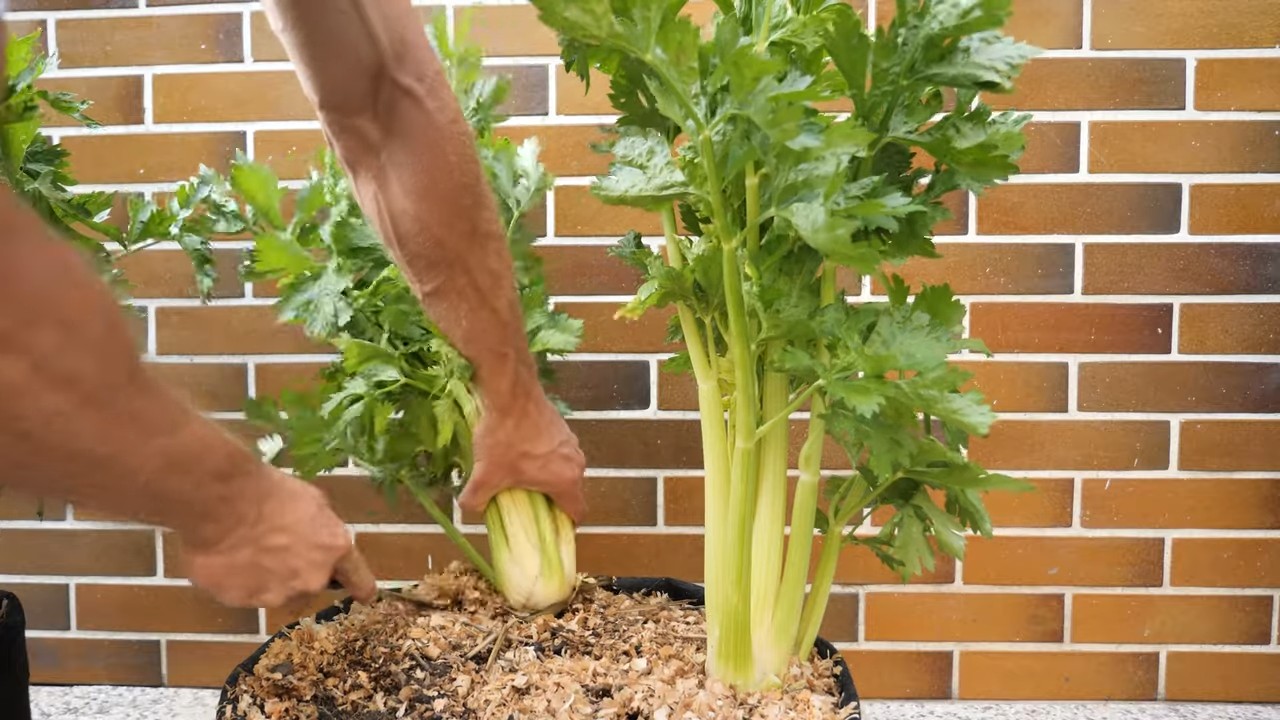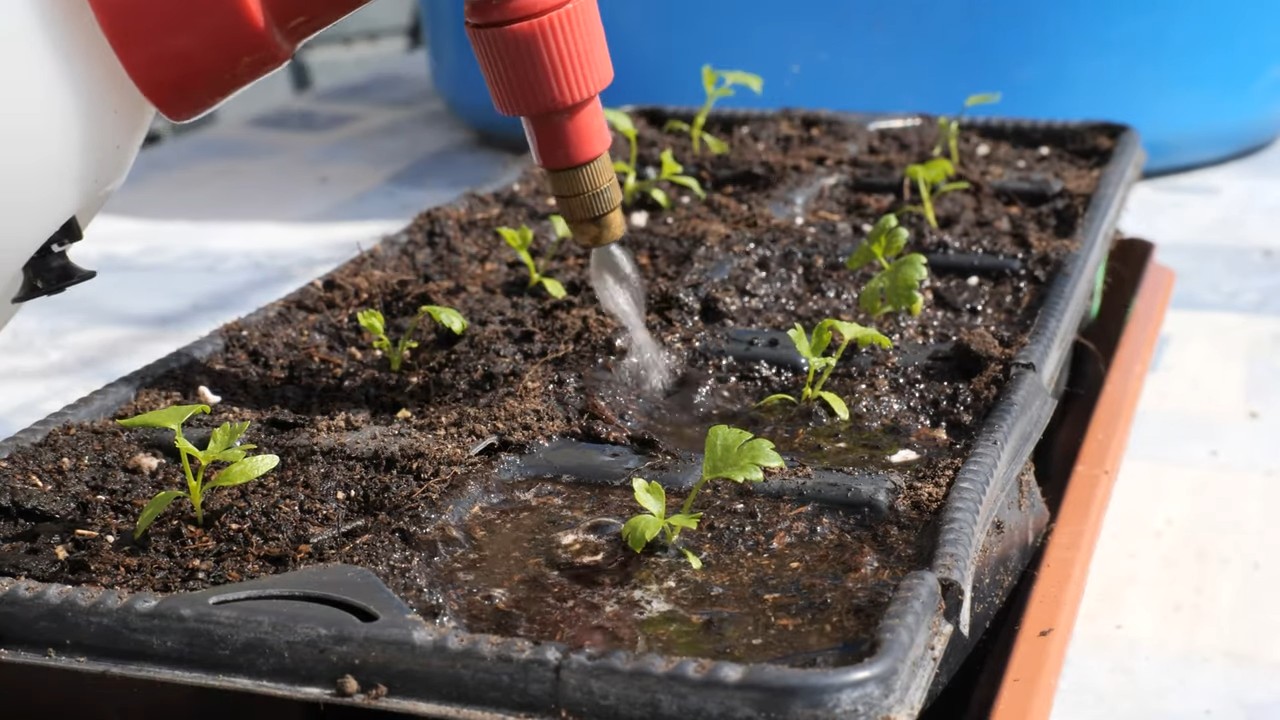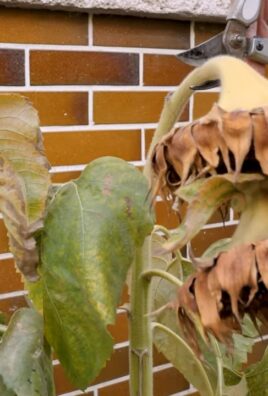Celery container gardening tips are your ticket to fresh, crunchy stalks right outside your door! Forget those limp, sad-looking celery bunches from the grocery store. Imagine snipping off exactly what you need, bursting with flavor and vitamins, all thanks to your own green thumb.
For centuries, celery has been valued not only for its culinary uses but also for its medicinal properties. From ancient Egyptians using it in wreaths to the Romans enjoying it as a flavoring, celery has a rich history. Now, you can easily bring this historical vegetable into your modern life, even without a sprawling garden!
Let’s face it, buying celery often means wasting half the bunch. It wilts in the fridge before you can use it all. That’s where celery container gardening tips come in handy. I’m going to show you how to grow your own celery in containers, saving you money, reducing food waste, and giving you access to the freshest celery possible. This DIY project is perfect for apartment dwellers, balcony gardeners, or anyone who wants to add a touch of green to their lives. Get ready to unlock the secrets to successful container celery and enjoy the satisfaction of harvesting your own homegrown goodness!

Growing Celery in Containers: A Beginner’s Guide
Hey there, fellow gardening enthusiasts! Ever thought about growing your own celery? It might seem intimidating, but trust me, with a little patience and the right setup, you can enjoy fresh, crunchy celery right from your patio or balcony. I’m going to walk you through everything you need to know to successfully grow celery in containers.
Choosing the Right Container and Soil
Before we even think about seeds, let’s talk about the foundation of our celery garden: the container and the soil.
* Container Size: Celery needs room to grow, both above and below the soil. I recommend a container that’s at least 12 inches deep and 12 inches in diameter. A larger container is even better, as it will hold more moisture and give the roots plenty of space to spread out. You can use a single large container for multiple celery plants, spacing them about 6-8 inches apart.
* Drainage: This is crucial! Celery loves moisture, but it hates sitting in soggy soil. Make sure your container has plenty of drainage holes. If it doesn’t, you can easily drill some.
* Soil: Celery thrives in rich, well-draining soil that’s high in organic matter. I like to use a mix of:
* Potting mix (this provides good drainage)
* Compost (for nutrients and moisture retention)
* A little bit of perlite or vermiculite (to further improve drainage)
You can buy pre-made potting mix, but I find that mixing my own gives me more control over the quality and nutrient content.
Starting Celery from Seed (or Seedlings!)
Celery can be a bit slow to germinate, so starting indoors is generally recommended, especially if you live in a cooler climate. You can also buy seedlings from your local garden center, which will save you some time.
Starting from Seed:
1. Sowing the Seeds: Celery seeds are tiny! I like to use a seed starting tray with individual cells. Fill the cells with your seed starting mix (a lighter mix than your final potting mix is ideal). Gently sprinkle a few seeds on top of each cell. Don’t bury them too deep; they need light to germinate. Just lightly press them into the soil.
2. Watering: Gently mist the soil with water. You want to keep the soil consistently moist, but not waterlogged. I find a spray bottle works best for this.
3. Creating a Humid Environment: Cover the seed starting tray with a clear plastic dome or plastic wrap. This will help to create a humid environment, which is essential for germination.
4. Providing Light: Place the tray in a warm location with bright, indirect light. A sunny windowsill can work, but a grow light is even better.
5. Germination: Celery seeds can take anywhere from 2 to 3 weeks to germinate. Be patient! Keep the soil moist and the humidity high. Once the seedlings emerge, remove the plastic cover.
6. Thinning: Once the seedlings have a few true leaves (the leaves that look like miniature celery stalks), thin them out so that only one strong seedling remains in each cell.
7. Hardening Off: Before transplanting the seedlings outdoors, you need to “harden them off.” This means gradually exposing them to outdoor conditions over a period of about a week. Start by placing them outside for an hour or two each day, gradually increasing the amount of time they spend outdoors. This will help them to acclimate to the sun, wind, and temperature changes.
Transplanting Seedlings (or Buying Seedlings):
1. Preparing the Container: Fill your container with your prepared potting mix, leaving a few inches of space at the top.
2. Digging the Holes: Dig holes in the soil that are large enough to accommodate the root balls of the seedlings. Space the holes about 6-8 inches apart.
3. Transplanting: Gently remove the seedlings from their cells. If they’re root-bound (the roots are tightly circling the bottom of the cell), gently loosen the roots before planting. Place the seedlings in the holes and backfill with soil.
4. Watering: Water the seedlings thoroughly after transplanting.
Caring for Your Celery Plants
Now that your celery plants are in their new home, it’s time to provide them with the care they need to thrive.
* Watering: Celery needs consistent moisture. Water deeply whenever the top inch of soil feels dry to the touch. Avoid letting the soil dry out completely, as this can cause the stalks to become bitter. I usually water every day or two, depending on the weather.
* Fertilizing: Celery is a heavy feeder, meaning it needs a lot of nutrients. I like to fertilize every two weeks with a balanced liquid fertilizer. You can also use a slow-release fertilizer at planting time.
* Sunlight: Celery prefers full sun (at least 6 hours of direct sunlight per day), but it can tolerate partial shade, especially in hot climates.
* Blanching (Optional): Blanching is the process of excluding light from the stalks to make them more tender and less bitter. You can do this by wrapping the stalks with newspaper or cardboard a few weeks before harvest. However, I personally don’t bother with blanching, as I find that homegrown celery is naturally less bitter than store-bought celery.
* Pest Control: Celery can be susceptible to a few pests, such as aphids and celery leaf tiers. Check your plants regularly for signs of infestation. If you find any pests, you can try spraying them with insecticidal soap or neem oil.
Harvesting Your Celery
The best part! You can start harvesting celery when the stalks are at least 6 inches long.
1. Harvesting Individual Stalks: You can harvest individual stalks as needed by cutting them off at the base of the plant with a sharp knife. This will allow the plant to continue producing new stalks.
2. Harvesting the Entire Plant: If you want to harvest the entire plant, simply cut it off at the base.
3. Storage: Freshly harvested celery can be stored in the refrigerator for up to two weeks. Wrap it in a damp paper towel and place it in a plastic bag.
Troubleshooting Common Celery Problems
Even with the best care, you might encounter a few problems along the way. Here are some common issues and how to address them:
* Bolting: Bolting is when the plant prematurely flowers and goes to seed. This can happen if the plant is stressed by heat or lack of water. To prevent bolting, make sure to keep the soil consistently moist and provide shade during the hottest part of the day.
* Bitter Stalks: Bitter stalks can be caused by a lack of water or nutrients. Make sure to water regularly and fertilize every two weeks.
* Yellowing Leaves: Yellowing leaves can be a sign of nutrient deficiency or overwatering. Check the soil moisture and adjust your watering accordingly. You may also need to fertilize the plant.
* Pests: As mentioned earlier, celery can be susceptible to pests. Check your plants regularly and take action if you find any pests.
Tips for Success
Here are a few extra tips to help you grow the best celery possible:
* Choose the Right Variety: Some celery varieties are better suited for container gardening than others. Look for compact varieties like ‘Golden Self-Blanching’ or ‘Utah Improved’.
* Provide Support: As the celery plants grow taller, they may need some support. You can use stakes or a tomato cage to keep them from falling over.
* Rotate Your Crops: To prevent soilborne diseases, rotate your crops each year. Don’t plant celery in the same container year after year.
* Enjoy the Process! Gardening should be fun! Don’t get discouraged if you encounter a few challenges along the way. Just keep learning and experimenting, and you’ll be rewarded with fresh, delicious celery in no time.
I hope this guide has inspired you to try growing your own celery in containers. It’s a rewarding experience, and you’ll be amazed at how much better homegrown celery tastes than store-bought celery. Happy gardening!

Conclusion
So, there you have it! Growing your own celery in containers is not only achievable, but it’s also incredibly rewarding. We’ve walked through the entire process, from selecting the right container and soil to nurturing your plants and harvesting your crisp, homegrown stalks. Why is this DIY trick a must-try? Because it puts fresh, flavorful celery right at your fingertips, regardless of your garden space. Imagine the convenience of snipping off exactly what you need for your soups, salads, or snacks, knowing it’s free from harmful pesticides and bursting with flavor.
Beyond the convenience and health benefits, container gardening with celery offers a unique connection to your food. You get to witness the entire life cycle of the plant, from tiny seedling to mature stalk, fostering a deeper appreciation for the food you consume. Plus, it’s a fantastic learning experience for gardeners of all levels.
But the fun doesn’t stop there! Feel free to experiment with different varieties of celery. While the classic Pascal celery is a popular choice, consider trying ‘Utah Tall’ for its disease resistance or ‘Golden Self-Blanching’ for its milder flavor. You can also explore companion planting by adding herbs like parsley or chives to your container, which can help deter pests and enhance the flavor of your celery. Another variation to consider is succession planting. By planting new celery seeds every few weeks, you can ensure a continuous harvest throughout the growing season.
Don’t be afraid to get creative with your container choices, too. While a standard pot works perfectly well, you could also repurpose old buckets, tubs, or even grow bags. Just make sure your chosen container has adequate drainage to prevent waterlogging.
Ultimately, the success of your container celery garden depends on your willingness to experiment and adapt. Pay close attention to your plants’ needs, adjust your watering and fertilizing schedule as necessary, and don’t be discouraged by occasional setbacks. Gardening is a journey, and every challenge is an opportunity to learn and grow.
We are confident that with a little patience and effort, you’ll be enjoying the taste of homegrown celery in no time. So, grab your seeds, prepare your containers, and embark on this exciting gardening adventure. We encourage you to try this DIY trick and share your experiences with us! Let us know what varieties you’re growing, what challenges you’ve encountered, and what successes you’ve celebrated. Share your photos and tips in the comments below – we can all learn from each other! Happy gardening!
Frequently Asked Questions (FAQ)
What is the best size container for growing celery?
A container that is at least 10-12 inches deep and 10-12 inches in diameter is ideal for growing celery. Celery needs room for its roots to develop properly. If you are planting multiple celery plants in one container, make sure to provide adequate spacing between them, about 6-8 inches apart. A larger container, such as a half-barrel planter, would be even better, allowing for more root growth and potentially larger, healthier celery stalks. Remember that the bigger the container, the more moisture it will retain, so adjust your watering schedule accordingly.
How often should I water my container celery?
Celery needs consistent moisture to thrive. Water your container celery deeply whenever the top inch of soil feels dry to the touch. This may mean watering every day, especially during hot, dry weather. Avoid letting the soil dry out completely, as this can stress the plants and lead to bitter-tasting stalks. However, be careful not to overwater, as soggy soil can lead to root rot. Ensure your container has good drainage to prevent water from pooling at the bottom. A good rule of thumb is to water slowly and deeply until you see water draining from the bottom of the container.
What kind of soil is best for container celery?
Celery prefers rich, well-draining soil that is high in organic matter. A good potting mix specifically formulated for vegetables is a great choice. You can also amend your potting mix with compost or well-rotted manure to improve its fertility and drainage. Avoid using garden soil in containers, as it can become compacted and doesn’t drain well. The ideal soil pH for celery is between 6.0 and 6.8. You can test your soil pH using a soil testing kit and amend it accordingly if necessary.
How much sunlight does container celery need?
Celery needs at least 6 hours of sunlight per day to thrive. Choose a location for your container that receives full sun. If you live in a hot climate, you may need to provide some afternoon shade to prevent the plants from scorching. You can also use shade cloth to protect your celery from intense sunlight. If you are growing celery indoors, you will need to supplement with grow lights to provide adequate light. Rotate your container regularly to ensure that all sides of the plant receive equal sunlight.
What are some common pests and diseases that affect container celery, and how can I control them?
Celery can be susceptible to several pests and diseases, including aphids, celery leaf tiers, and fungal diseases like early blight and late blight. Regularly inspect your plants for signs of pests or diseases. Aphids can be controlled with insecticidal soap or neem oil. Celery leaf tiers can be handpicked or treated with Bacillus thuringiensis (Bt). To prevent fungal diseases, ensure good air circulation around your plants and avoid overhead watering. If fungal diseases do occur, treat them with a fungicide labeled for use on celery. Companion planting with herbs like basil or marigolds can also help deter pests.
How long does it take to grow celery in containers?
Celery typically takes 100-130 days to mature from seed. You can speed up the process by starting seeds indoors 8-10 weeks before the last expected frost. Transplant seedlings into your containers after the danger of frost has passed. You can also purchase celery transplants from a nursery to get a head start. Be patient, as celery can be a slow-growing crop.
Can I grow celery from the base of a store-bought stalk?
Yes, you can regrow celery from the base of a store-bought stalk. Cut off the celery stalks about 2 inches from the base. Place the base in a shallow dish of water, with the cut side facing up. Place the dish in a sunny location and change the water every day. After a few days, you should see new roots and leaves emerging from the base. Once the roots are about an inch long, you can transplant the celery base into a container filled with potting mix. This method is a fun and easy way to propagate celery, but the resulting stalks may not be as large or robust as those grown from seed.
How do I harvest my container celery?
You can harvest celery stalks as needed once they reach a desirable size. Simply cut off the outer stalks near the base of the plant. The inner stalks will continue to grow and mature. You can also harvest the entire plant at once by cutting it off at the base. Celery is best harvested in the morning when the stalks are crisp and cool. Store harvested celery in the refrigerator for up to two weeks.
How do I blanch my container celery?
Blanching celery stalks can improve their flavor and texture. To blanch celery, exclude light from the stalks for a few weeks before harvesting. You can do this by wrapping the stalks with newspaper, cardboard, or soil. Make sure to leave the tops of the stalks exposed to sunlight. Blanching reduces the amount of chlorophyll in the stalks, resulting in a milder, sweeter flavor. Self-blanching varieties of celery are also available, which naturally blanch themselves as they grow.




Leave a Comment